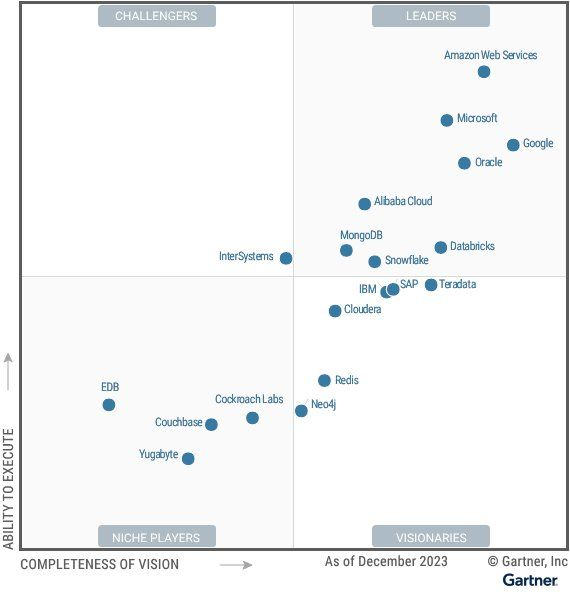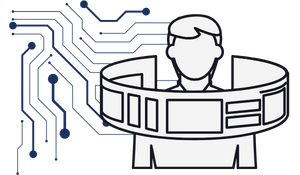As the first quarter of 2024 comes to a close, I wanted to take a look back at some of the many highlights and developments in the world of data, AI, and technology as a whole. As I have said many times in the past, technology moves a such a fast pace that if you blink you will be sure to have missed something. While some of the things I cover are too big to miss, I want to make sure that I capture the things that I find the most fascinating and relevant to today as well as share my thoughts on where things are headed. We will be looking at a collection of 6 topics, stories, and releases that I hope you find as interesting as I do.
- Industry Report: Gartner Magic Quadrant for Cloud Database Management Systems
- Podcast Pick: Jessica Talisman (Amazon) joins Catalog & Cocktails to discuss Information Architecture
- SME News: SME Launches AI Readiness Kit
- Data in the News: Frank Slootman steps down as Snowflake CEO
- Cool Tech: OpenAI Sora
- Everyday Tech – Outages, outages, outages
Industry Report: Gartner Magic Quadrant for Cloud Database Management Systems
 Starting off the list with a Gartner Magic Quadrant from….2023? While technically this was released in December of 2023, most people didn’t get a chance to see the report until this past January (so I think it counts for Q1!). This report focuses on cloud database management systems, a landscape that is very broad but at the center of every data ecosystem. It is important to note that each point on the quadrant represents a company and not an individual tool. For databases specifically, many of these companies have multiple database offerings. These include (not limited to) relational/transactional databases, analytical databases/data warehouses, NoSQL databases, key-value stores/caches, graph databases, and hybrid databases.
Starting off the list with a Gartner Magic Quadrant from….2023? While technically this was released in December of 2023, most people didn’t get a chance to see the report until this past January (so I think it counts for Q1!). This report focuses on cloud database management systems, a landscape that is very broad but at the center of every data ecosystem. It is important to note that each point on the quadrant represents a company and not an individual tool. For databases specifically, many of these companies have multiple database offerings. These include (not limited to) relational/transactional databases, analytical databases/data warehouses, NoSQL databases, key-value stores/caches, graph databases, and hybrid databases.
Because of my point above, I am not too too surprised by the overall placement of the companies that earned a spot. AWS, Microsoft, and Google being the cloud giants and having an offering for each kind of database makes sense as to why they lead the pack. I could also say something similar about Oracle with their tenure in the space. When you look at the other end at the Niche Players and Visionaries, you see some companies with specific offerings: Yugabyte and EDP are managed Postgres, Couchbase is NoSQL, Neo4J is graph, Redis is key-value, Cockroach is hybrid). When you get towards the center of the quadrant, you find MongoDB, which I think makes sense because it is arguably the most widely-used standalone NoSQL database (at least according to db-engines.com). IBM, SAP, Cloudera, and Teradata being grouped similarly at the top of the visionaries section seems very appropriate. I hope it is not too hot a take to say that these are former heavyweights that are struggling to keep up with the modern market.
Speaking of the modern market, Snowflake and Databricks both landed in the Leaders section but Databricks edged out Snowflake on both completeness of vision and ability to execute. Both were praised for their respective strengths: Snowflake having extreme ease of use and a growing market mind share, and Databricks having robust data science capabilities and excellent scalability. I think when you look at things like Snowpark and Databricks SQL, you can see that these strengths can be applied to both tools. And as with most tools that come with consumption-based models, both tools were cautioned for their spend prediction and pricing, something I don’t think they are getting away from anytime soon.
In reviewing Magic Quadrants, this particular one generally doesn’t see too much crazy movement year over year. And I think that it has to be re-iterated that every time you read a magic quadrant, getting placed higher to the right doesn’t equal that tool/company is better than another. Especially because a lot of these databases solve vastly different use cases than others. I wouldn’t build a data warehouse on Redis, nor would I use Google BigQuery for just a cache.
Podcast Pick: Jessica Talisman (Amazon) joins Catalog & Cocktails to discuss Information Architecture
Catalog and Cocktails, hosted by data.world’s Juan Sequeda and Tim Gasper, brings the listener an honest, no BS conversation about enterprise data management with industry leaders and visionaries over the course of a tasty beverage. In one of their January episodes, they welcomed Jessica Talisman, information architect at Amazon to talk about information architecture and why it is more applicable today than ever in the world of embracing generative AI. To quote Jessica,
“Information architecture is the act of organizing information …to support findability and discovery. It involves research and it involves cleaning data and knowing the stakeholders, knowing the platforms…”
The conversation explores the need for companies to invest in their information architecture just as they do with their data architecture. While the two are most certainly related, information architecture provides the semantics, translations, and hierarchies needed to interpret data and benefit both front-end and back-end experiences. As humans, we all tend to operate with hierarchies in our brains, so why treat enterprise information any differently? But design is not so cut and dry. An example they referenced in relation to making cooking ingredients, some people may refer to tomatoes and mushrooms as vegetables, although they aren’t. Whereas revenue reporting has to abide by a strict taxonomy. But can we build systems to support both strict and loose taxonomies? The answer is yes!
Information retrieval systems are founded on structures that incorporate taxonomies, thesauri, vocabulary, ontologies, and catalogs to build the relationships and mappings between the data, the context, and the people that make up an organization. And LLM’s and generative AI operate the most efficiently (and most cost-effectively) on well-organized systems. So it is a no-brainer that information architecture is a critical step on the journey to AI-readiness. I highly recommend giving the podcast a listen or watch, and enjoy your cocktail of choice when you do!
https://data.world/podcasts/without-information-architecture-there-is-no-ai-with-jessica-talisman/
SME News: SME Launches AI Readiness Kit
The most asked question I received last year was some variation of “How does my company get ready for AI?” It’s a great question. AI is dominating the airwaves not only in the tech circle but also in major news outlets and internet spaces. Everyone wants to use AI….but do they know what they want to use it for? Or what it takes to flip the switch with confidence that it will work for their use cases?
It may seem like a tall order and very confusing. That is why SME created its AI Readiness Kit, an essential guide to start navigating the world of Artificial Intelligence.
The kit covers the basics of understanding AI’s capabilities and prerequisites. This includes cultural readiness, data organization and governance, discussion questions, and understanding terminology. This kit serves as an excellent foundation for constructing a roadmap and strategy to identify the key stakeholders and components necessary for an AI project, along with anticipating the potential costs and obstacles that are likely to arise along the journey.
The AI Readiness Kit is free and easy to access: https://www.smesgroup.com/ai-readiness-kit
Data in the News: Frank Slootman steps down as Snowflake CEO
Typically when Snowflake makes a major company announcement, I get messages from two groups of people. One being my colleagues in the tech community. The other being colleagues that follow the SNOW ticket on the New York Stock Exchange. On February 28th, my iPhone blew up with emails and texts from both groups. Snowflake announced that CEO Frank Slootman would be stepping down immediately and retiring, resulting in a more than 20% plunge in their stock price after trading hours. The news came as a shock and surprise with how sudden it occurred. Snowflake appointed Sridhar Ramaswamy, Snowflake’s SVP of AI, as its new CEO. Ramaswamy was the CEO and co-founder of Neeva, the world’s first private AI-powered search engine, which was acquired by Snowflake in 2023. Ramaswamy also previously led Google’s advertising and commerce division. While Slootman’s replacement seems like a solid candidate to fill his shoes, the sudden departure and his close connection with the company and its success has spurred a lot of worry.
I am not a financial analyst by any means so I will not comment on Snowflake’s stock price. However, I can and will say that, especially in the short term, I do not see this having a major effect on Snowflake as a cloud data platform. Leadership changes happen. And in almost all cases, it does not massively swing product direction or focus in the opposite direction. But by looking at new CEO Ramaswamy’s background, having leadership that has experience in managing and operating a company focused on AI shows that the company is further leaning into AI. With the release of Cortex and acquisitions of companies like Neeva, Streamlit, and Applica, Snowflake is still positioned to expand the Data Cloud beyond relational data warehousing and widen its scope to applications, generative AI, and machine learning.
https://www.snowflake.com/news/sridhar-ramaswamy-named-chief-executive-officer-of-snowflake/
Cool Tech: OpenAI Sora
I think at this point everyone knows about OpenAI, or at least their LLM chatbot ChatGPT. Over the past year, generative AI has taken the world by storm, and ChatGPT is a large reason for it. Sora, is OpenAI’s text-to-video model that takes text prompts and creates hyperrealistic and imaginative scenes of up to 60 seconds in length. In a release promotional video that I have linked below, OpenAI demos various prompts that showcase Sora’s versatility and quality. What is shown is simply mind-blowing. The videos generated by Sora have incredible realism, detail, and clarity that look like they were shot by the highest quality cameras or animated by professionals. It seems to have surpassed everyone’s expectations of what video generation is capable of. People are already speculating on how this will evolve and change the landscape of video and film. And while this is amazing in terms of where AI is headed, it also has garnered a lot of concern.
The massive leap toward AI-generated videos of this caliber has raised eyebrows among people working in the film, entertainment, and video industries. Just with AI-generated images, artists criticize Sora for its ability to generate art without creativity and expression. In its current form, Sora looks like it could be fantastic for generating stock video. But what comes next? Feature films, television series, or video games that users can generate in a couple of sentences? This is speculation but Sora is another step towards that reality. And with this, jobs can be placed in jeopardy. But the largest concern is that of ethics. While Sora is not available to the public and is only used for red teams now, the idea that Sora could potentially generate malicious, explicit, or duplicitous content is something that will need to be extremely regulated.
Sora inspires both excitement and anxiety for the future of AI and video/content generation. Only time will tell what Sora’s impact on the world will be. But I think that combining its power with human creativity is going to unlock doors that we once thought were science fiction.
Everyday Tech – Outages, outages, outages
As a tech enthusiast with countless smart and internet-connected devices in my home, car, and life, outages are no fun. When my internet goes out in my house, I feel like I lose access to over half my activities and stuff. Usually, I pass the time by opening a book and hoping I am back online within a couple of minutes. But when an outage doesn’t last minutes but instead goes on for hours, productivity and plans get disrupted. And that is just for me, an individual person. When you multiply that to entire neighborhoods, organizations, and networks, things can get chaotic pretty quickly.
Last quarter I witnessed more outages in a short period than I have in recent memory. Meta experienced an outage that took down Facebook and Instagram for a couple of hours. Nothing crazy but still noticeable. Another day I received an alert that two of our Azure VMs failed to allocate and start up. The official Azure status page showed all green but sites like Downdetector and Reddit were painting a different picture. While our VMs were thankfully only demo environments, people in our region shared that their enterprise environments were unavailable for large portions of the day, hampering business operations. But hands down the largest, most well-known outage occurred on February 22nd, where hundreds of thousands of AT&T subscribers across the US experienced disrupted or no service for almost 11 hours. While an investigation is underway, AT&T reported the error to be caused by an internal error. Still, an outage of that magnitude caused major ripples for many people on multiple levels of severity.
Outages happen and most of the time they are hard to predict. However, that does not mean we cannot prepare for them. As most of our applications move to cloud and SaaS-based services, it is critical to understand what redundancies, failover, and backup plans are in place in the case for service disruption. I always look to see if my applications have an “offline mode” or download option to keep some of my work locally in case service is spotty or unavailable. It could come in handy when you least expect it. And in the case of a total outage, make sure you always have a good book ready to be read on the shelf!
Conclusion
While the first quarter may be over, 2024 is in full swing. These topics and events were just a few of the many highlights that we experienced so far. I am optimistic that the rest of the year will continue to bring us new technological innovations, exciting breakthroughs, and new ways for us to increase productivity. I am always keeping my eyes and ears open to learn new things, so if you want to discuss these topics or maybe another topic that you find interesting, you can message me on LinkedIn. I hope you had a great first quarter and have an even better second quarter!
Get In Touch With Us Today
.png?width=700&height=127&name=Blue%20Mantis%20formerly%20known%20as%20SME%20Solutions%20Group%2c%20Inc.%20(GREEN).png)

.jpg)

